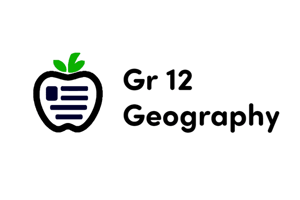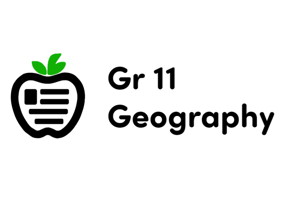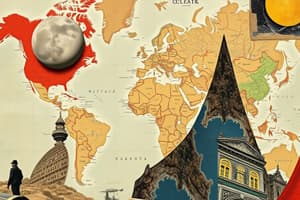Podcast
Questions and Answers
Which of the following Canadian cities is situated on an important river and acts as a hub for exporting wheat to the world?
Which of the following Canadian cities is situated on an important river and acts as a hub for exporting wheat to the world?
- Vancouver
- Montreal
- Winnipeg
- Calgary (correct)
What city is the capital of Canada?
What city is the capital of Canada?
Ottawa
The Mercator Projection is an accurate and very commonly used map projection.
The Mercator Projection is an accurate and very commonly used map projection.
False (B)
What is the difference between a precipitation that's cyclonic, relief or convection?
What is the difference between a precipitation that's cyclonic, relief or convection?
Which of these is a major geographical feature located on the landmass of Canada? Choose all that apply.
Which of these is a major geographical feature located on the landmass of Canada? Choose all that apply.
What is the difference between a climatogram and a climograph?
What is the difference between a climatogram and a climograph?
Which of the following is NOT a type of soil in the Canadian soil profile?
Which of the following is NOT a type of soil in the Canadian soil profile?
What is the difference between a lessive soil and a calcareous soil?
What is the difference between a lessive soil and a calcareous soil?
What is the significance of the location of a transition zone within a soil profile?
What is the significance of the location of a transition zone within a soil profile?
What are ecozones?
What are ecozones?
How many ecozones are contained in Canada?
How many ecozones are contained in Canada?
What are the various terms used to describe population trends and changes?
What are the various terms used to describe population trends and changes?
A 'baby boom' is a short period of time when a large number of births occur.
A 'baby boom' is a short period of time when a large number of births occur.
Why might a 'baby boom' be concerning to governing bodies?
Why might a 'baby boom' be concerning to governing bodies?
How does an independent territory differ from a dependant territory?
How does an independent territory differ from a dependant territory?
What are some key differences between an immigrant and an emigrant?
What are some key differences between an immigrant and an emigrant?
How does the process of assimilation affect the people of a country?
How does the process of assimilation affect the people of a country?
What are the three levels of 'occupation of the land' in Canada?
What are the three levels of 'occupation of the land' in Canada?
What is the difference between climate and weather?
What is the difference between climate and weather?
The Canadian climate is strongly influenced by the proximity to the Arctic Ocean and the Atlantic Ocean, but is also influenced by vast mountain ranges.
The Canadian climate is strongly influenced by the proximity to the Arctic Ocean and the Atlantic Ocean, but is also influenced by vast mountain ranges.
What are some factors that influence Canada's maritime climate?
What are some factors that influence Canada's maritime climate?
What is the main type of fish found in abundance along the Atlantic Coast of Nova Scotia?
What is the main type of fish found in abundance along the Atlantic Coast of Nova Scotia?
What is the main characteristic of a continental climate?
What is the main characteristic of a continental climate?
What is the difference between a continental climate and a maritime climate?
What is the difference between a continental climate and a maritime climate?
Provide an example of a city that has a continental climate and a city that has a maritime climate in Canada.
Provide an example of a city that has a continental climate and a city that has a maritime climate in Canada.
What factors influence the climate of Canada's 7 physiographic regions?
What factors influence the climate of Canada's 7 physiographic regions?
Flashcards
Plate Tectonics
Plate Tectonics
The theory that Earth's outer layer, the lithosphere, is made of large plates that move slowly over time.
Continental Drift
Continental Drift
The process where continents move across the Earth's surface over millions of years.
Igneous Rock
Igneous Rock
A type of rock formed from the cooling and solidification of molten rock.
Metamorphic Rock
Metamorphic Rock
Signup and view all the flashcards
Sedimentary Rock
Sedimentary Rock
Signup and view all the flashcards
Erosion
Erosion
Signup and view all the flashcards
Glacial Erosion
Glacial Erosion
Signup and view all the flashcards
Fossils
Fossils
Signup and view all the flashcards
Climate
Climate
Signup and view all the flashcards
Maritime Climate
Maritime Climate
Signup and view all the flashcards
Continental Climate
Continental Climate
Signup and view all the flashcards
Climatogram
Climatogram
Signup and view all the flashcards
Population Distribution
Population Distribution
Signup and view all the flashcards
Demographics
Demographics
Signup and view all the flashcards
Urbanization
Urbanization
Signup and view all the flashcards
Population Pyramid
Population Pyramid
Signup and view all the flashcards
Immigration
Immigration
Signup and view all the flashcards
Autochthonous Populations
Autochthonous Populations
Signup and view all the flashcards
Economic Activities
Economic Activities
Signup and view all the flashcards
Study Notes
Unit 1 - Geographical Skills
- Canada has 10 provinces and 3 territories
- Major cities, rivers, lakes, and bodies of water of Canada are identified
- Canadian capital cities are identified
- Globes and maps represent earth's surface
- Different map projections (Mercator, Conic, Equivalent) present distortions and variations
- Defining terms like scale, topographic maps, grids, and coordinates are covered
- Different types of scales and examples for each are given
- Geographical locations (continents, latitude, longitude, time zones) are discussed
- Differences between large and small scale maps are explained
Unit 2 - Physical Connections: Geological History
- Continental drift theory and its acceptance/rejection
- Plate tectonic theory, its timeline and proposer (Alfred Wegener)
- Composition of the Earth's crust, plate count and locations
- Plate movement causes changes on Earth's surface (earthquakes, volcanoes, Pangea formation)
- Explaining terms like erosion and fossil
- Forms of igneous rocks, intrusive and extrusive rock examples
- Formation and examples of sedimentary rocks are included
Unit 3 - Ecozones
- Identification of 7 Canadian physiographic regions
- Differences between climate and weather
- Climatic factors (example: CLEVER for Canada) are discussed
- Precipitation and temperature differences between marine and continental climates
- Examples of cities with marine and continental climates are provided
- Types of precipitation (cyclonic, relief, convection) and associated Canadian city examples are given
- Methods to create climatograms and compute average temperature/precipitation
- Soil composition (lessivé, calcifié) and transition zones are shown
- Canadian ecozones and their population distribution are discussed
Unit 4 - Cultural Connections: Population
- Demography, birth rate, mortality rate, natural increase, and emigration, and net migration are defined and explained
- Discussions of population pyramids (baby boom generation's impact and implications on current/future generations)
- Indigenous peoples' (assimilation, assimilated, autonomous) situation, historical events (Proclamation of 1713, the Indian Act)
- factors influencing their current lives; government policies, difficulties, suicide and drug issues in certain regions are explored
Unit 5 - Economic Connections
- Examples of primary, secondary, and tertiary industries
- Work sector choice and reasons
- Most important industries in several Canadian provinces
Studying That Suits You
Use AI to generate personalized quizzes and flashcards to suit your learning preferences.




